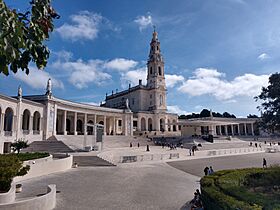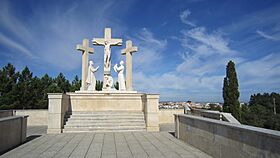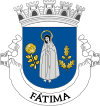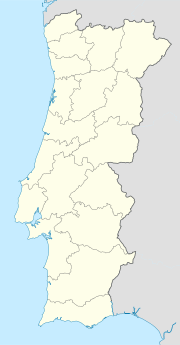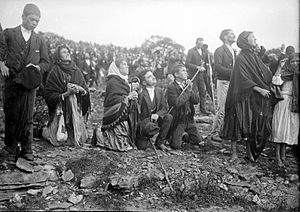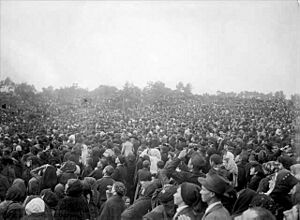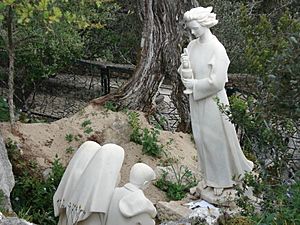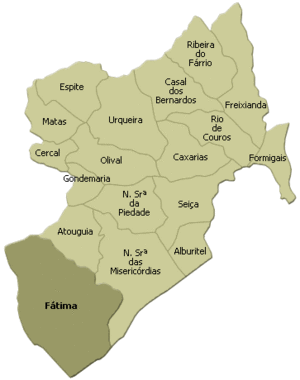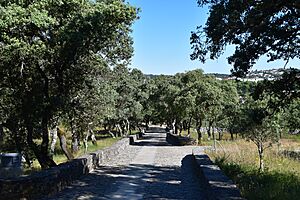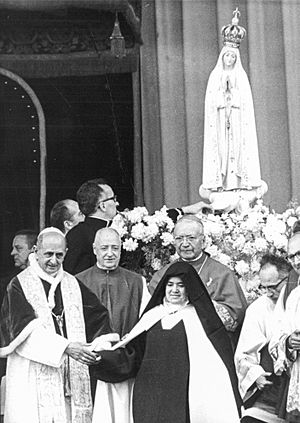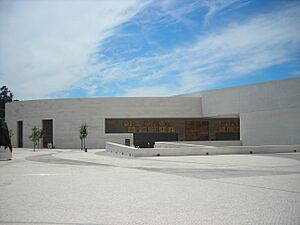Fátima, Portugal facts for kids
Quick facts for kids
Fátima
|
|||
|---|---|---|---|
|
Civil parish
|
|||
|
From top left to right: The Sanctuary of Our Lady of Fátima, the main avenue in Cova da Iria, the Basilica of the Holy Trinity, house of Francisco and Jacinta Marto in Aljustrel and the Hungarian Calvary in Valinhos.
|
|||
|
|||
| Country | |||
| Region | Oeste e Vale do Tejo | ||
| Intermunic. comm. | Médio Tejo | ||
| District | Santarém | ||
| Municipality | Ourém | ||
| Area | |||
| • Total | 71.29 km2 (27.53 sq mi) | ||
| Elevation | 356 m (1,168 ft) | ||
| Population
(2021)
|
|||
| • Total | |||
| Time zone | WET/WEST (UTC+0/+1) | ||
| Postal code |
2495
|
||
| Area code | 249 | ||
| Patron | Our Lady of Pleasures Our Lady of Fátima |
||
Fátima is a city in Portugal. It is located in the district of Santarém, within the Ourém area. The city covers about 71 square kilometers (27 square miles) and has a population of over 13,000 people (as of 2021).
Fátima is famous worldwide for its connection to Our Lady of Fátima. This refers to a series of events in 1917. Three young shepherd children said they saw visions of a "lady dressed in white." The Catholic Church later said these events were "worthy of belief." A small chapel was built where the visions happened. This chapel is now part of the Sanctuary of Our Lady of Fátima. This large religious site attracts millions of visitors every year.
Contents
History of Fátima
How Fátima Got Its Name
The name Fátima comes from an Arabic girl's name, Fátima. A long time ago, a brave knight named Gonçalo Hermigues captured a Moorish princess named Fátima. He took her to a small village in the hills.
Princess Fátima fell in love with the knight. She decided to become a Christian to marry him. She was baptized and given the Christian name "Oureana." However, the place is still known by her original Arab name, Fátima.
Visions and the "Sun Miracle"
The town of Fátima was officially started in 1568. For many years, most people in the area were farmers and sheep herders.
In the 1700s, Fátima became known for stories about visions of the Virgin Mary. One story tells of the Virgin Mary appearing to a young shepherdess. This happened in a part of Fátima called Ortiga. The shepherdess, who could not speak, was able to talk after this vision. This led to the building of the Sanctuary of Our Lady of Ortiga in 1758.
Later, in 1917, three young children from Fátima said they saw visions of a "lady dressed in white." These children were Lúcia dos Santos and her cousins, Francisco and Jacinta Marto. They were watching their families' sheep in a place called Cova da Iria. The children said the lady appeared to them six times.
The children said the last vision would happen on October 13, 1917. About 70,000 people came to see this event. Many people reported seeing the sun appear to move strangely in the sky. This event is now known as the Miracle of the Sun.
Church leaders looked into these events. They decided that the visions were true. A small chapel was built at the site in 1918. Over time, this chapel grew into a large religious complex. It includes a big church and other buildings for visitors. In 1930, the statue of Our Lady in the chapel was officially recognized by the Vatican.
Sadly, Francisco died in 1919 and Jacinta in 1920. They passed away during a worldwide sickness called the Spanish flu. Lúcia dos Santos became a nun and lived until 2005. Francisco and Jacinta are now considered saints by the Catholic Church. They were made saints by Pope Francis in 2017.
Growth of Fátima
The building of the sanctuary and the many visitors helped Fátima grow. The town became a city on July 12, 1997.
In the early 2000s, some people in Fátima wanted it to become its own separate area. However, the President of Portugal, Jorge Sampaio, did not approve this plan in 2003.
Geography and Climate
Where Fátima Is Located
Fátima is in the central-west part of Portugal. It is on a high flat area, about 356 meters (1,168 feet) above sea level. This makes it higher than most other areas in Ourém.
The land around Fátima is made of limestone. This type of rock creates interesting natural features. You can find sinkholes, valleys, and caves with stalactites and stalagmites.
The soil in Fátima is porous, meaning water drains through it easily. This can make water scarce in the summer. However, there is a lot of rain in autumn, winter, and spring. The plants here are used to dry summers. You can see trees like holly oak, strawberry trees, and olive trees. Pine and eucalyptus forests are also common.
Fátima's Climate
Fátima has a warm-summer Mediterranean climate. This means it has hot, dry summers and mild, wet winters.
It gets about 1150 millimeters (45 inches) of rain each year. This is more rain than other nearby cities, partly because Fátima is higher up.
In winter, daytime temperatures are around 13°C (55°F). Nights can get down to 4°C (39°F). January is usually the coldest month. Light frosts can happen from December to February.
Summer temperatures are usually around 27°C (81°F) during the day and 15°C (59°F) at night. Sometimes, temperatures can go above 35°C (95°F). When it's very hot and dry, there can be a risk of forest fires.
Fátima gets about 2600 hours of sunshine each year. Snow is rare, but it has happened a few times, like in 2013 and 2016.
| Climate data for Boleiros, Fátima, altitude: 320 m (1,050 ft), 1984-2002 | |||||||||||||
|---|---|---|---|---|---|---|---|---|---|---|---|---|---|
| Month | Jan | Feb | Mar | Apr | May | Jun | Jul | Aug | Sep | Oct | Nov | Dec | Year |
| Average precipitation mm (inches) | 173.7 (6.84) |
124.3 (4.89) |
85.1 (3.35) |
107.1 (4.22) |
88.2 (3.47) |
30.7 (1.21) |
7.1 (0.28) |
7.8 (0.31) |
62.5 (2.46) |
128.5 (5.06) |
160.2 (6.31) |
175.7 (6.92) |
1,150.9 (45.32) |
| Source: Portuguese Environment Agency | |||||||||||||
Cities Fátima Is Connected To
Fátima has special connections with other cities around the world. These are called "twin towns" or "sister cities." They include:
 Częstochowa in Poland
Częstochowa in Poland Loreto in Italy
Loreto in Italy Droß in Austria
Droß in Austria Altötting in Germany
Altötting in Germany Lourdes in France
Lourdes in France Selçuk in Turkey
Selçuk in Turkey
Economy and Tourism
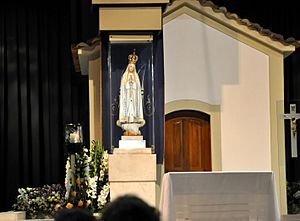
The main way Fátima makes money is through religious tourism. Millions of Christian pilgrims visit the city every year. Many local shops sell religious items and souvenirs. Hotels, restaurants, and other businesses also benefit from the visitors.
Other jobs in the area include:
- Working with marble
- Saw-milling (cutting wood)
- Carpentry (woodwork)
- Building houses and other structures
- General commerce and services
Visits by Popes


Several Popes have visited Fátima over the years:
- May 1967 – Pope Paul VI
- May 1982 – Pope John Paul II (1st visit)
- May 1991 – Pope John Paul II (2nd visit)
- May 2000 – Pope John Paul II (3rd visit)
- May 2010 – Pope Benedict XVI
- May 2017 – Pope Francis (1st visit)
- August 2023 – Pope Francis (2nd visit)
Buildings and Landmarks
Important Civic Buildings
Fátima has several important public buildings and landmarks:
- The Bus Station of Fátima
- The Civil Parish Building of Fátima (local government office)
- The homes of the children who saw the visions:
- The Residence of Francisco and Jacinta Marto
- The Residence of Lúcia dos Santos
- The Monument of the Three Little Shepherds
Religious Buildings
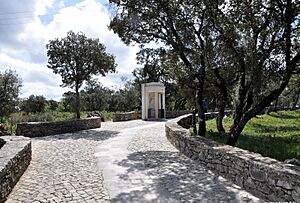
Fátima is home to many important religious sites:
- The Sanctuary of Our Lady of Fátima: This is the main religious complex.
- The Chapel of the Apparitions: This small chapel is built where the visions were said to have happened.
- The Basilica of Our Lady of the Rosary: This church has a tall tower and was started in 1928. It holds the tombs of Francisco, Jacinta, and Lúcia.
- The Basilica of the Holy Trinity: This is one of the largest churches in the world. It was built in the early 2000s.
- The Sanctuary of Our Lady of Ortiga: This older sanctuary is linked to an 18th-century vision.
- The Parochial Church of Fátima: The local parish church.
- The Stations of the Cross of Valinhos: A path with statues showing the journey of Jesus.
- Statues of the Angel of Portugal: These statues mark places where an angel appeared to the children.
- The Byzantine Chapel of the Holy Dormition: This chapel has a unique onion dome and is used by the local Ukrainian Greek Catholic community.
Culture and Sports
Cultural Importance
The Sanctuary of Our Lady of Fátima is the main reason people visit Fátima. Every year, millions of Catholic pilgrims travel to this holy site. On May 13 and October 13, the most important dates of the visions, hundreds of thousands of people visit.
Sports in Fátima
Fátima has a main sports club called the Sport Center of Fátima. This club has a football (soccer) team that plays in Portugal's second-highest league, the LigaPro.
See also
 In Spanish: Fátima (Portugal) para niños
In Spanish: Fátima (Portugal) para niños


